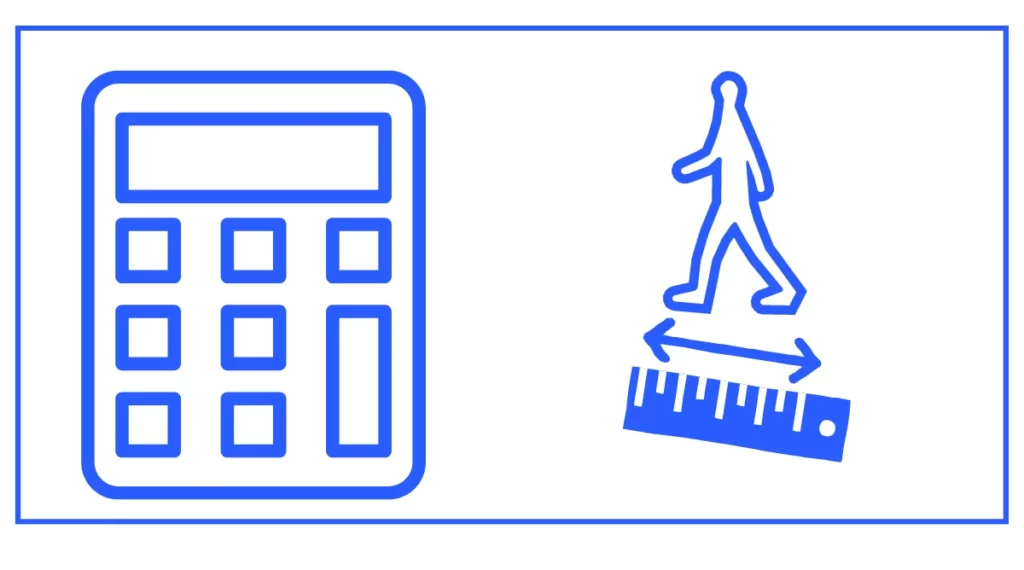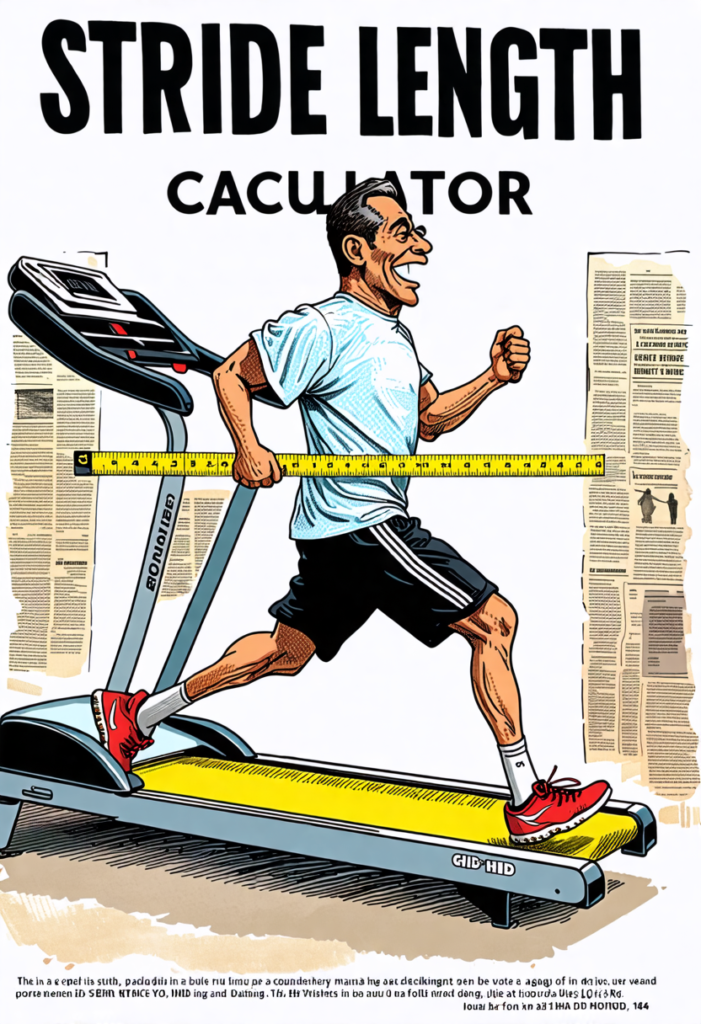Stride Length Calculator
Your stride length:
Your stride is than the average – 2.5 feet (76.2 cm)
Are you looking for an easy way to convert the distance walked and steps taken into stride length?
You can easily calculate the stride length by entering the distance walked and the steps taken. The results also show whether your stride length is equal to others, longer than average, or shorter.

You might find the walking calories and steps into miles converters useful.
What is Stride Length?
Stride length is the distance between the heel strike of one foot and the next heel strike of the same foot. It’s essentially two steps combined. For example, if you take a step with your right foot, then your left foot, and then your right foot again, the distance between the first and second right foot contact points is your stride length.
Factors that influence stride length include:
- Height
- Leg length
- Walking or running speed
- Terrain
- Physical fitness
- Age
Understanding your stride length can be beneficial for various reasons, including:
- Improving walking or running efficiency
- Tracking fitness progress
- Estimating distances more accurately
- Setting realistic goals for step counts or distances
How to Calculate Your Stride Length?
There are several methods to calculate your stride length. Let’s explore some of the most common and accurate approaches.
Method 1: The Measured Distance Approach
This method is simple and can be done with minimal equipment:
- Measure a known distance, preferably 20 to 30 feet.
- Walk this distance naturally, counting your steps.
- Divide the total distance by the number of steps taken.
- Multiply the result by 2 to get your stride length.
For example, if you walk 30 feet in 15 steps:
30 feet ÷ 15 steps = 2 feet per step
2 feet × 2 = 4 feet stride length
Method 2: Using Your Height
While less accurate than the measured distance method, you can estimate your stride length based on your height:
- For men: Multiply your height in inches by 0.415
- For women: Multiply your height in inches by 0.413
For instance, a man who is 70 inches tall would have an estimated stride length of:
70 × 0.415 = 29.05 inches (about 2.42 feet)
Method 3: Step Length Calculator
Our free stride length calculator tool simplifies the process. Here’s how to use it:
- Enter the distance walked in meters
- Input the number of steps taken
- Click “Calculate”
The calculator will then display your stride length in centimeters and compare it to the average stride length of 2.5 feet (76.2 cm).
Understanding the Results
Once you’ve calculated your stride length, it’s important to interpret the results. The average stride length for adults is about 2.2 to 2.5 feet. However, this can vary based on factors like height, leg length, and walking speed.
If your stride length is shorter than average, it might indicate:
- You’re taking more steps to cover the same distance
- You may have a slower walking pace
If your stride length is longer than average, it could mean:
- You’re covering more ground with each step
- You may have a faster walking pace
Remember, there’s no “perfect” stride length. The goal is to find a comfortable, efficient stride that works for your body and fitness level.
Applications of Stride Length
Understanding your stride length has several practical applications:
1. Estimating Distance
Knowing your stride length allows you to estimate distances more accurately. For example, if your stride length is 2.5 feet and you take 2000 steps, you can estimate the distance walked:
2.5 feet × 2000 steps = 5000 feet ≈ 0.95 miles
2. Setting Step Goals
Many fitness trackers and apps use an average stride length to convert steps to distance. By inputting your actual stride length, you can get more accurate results and set more realistic step goals.
3. Improving Running Efficiency
Runners can use stride length information to optimize their technique. A longer stride isn’t always better – finding the right balance between stride length and cadence (steps per minute) is key to efficient running.
4. Tracking Fitness Progress
As you become fitter, your stride length might naturally increase. Regularly measuring your stride length can be a way to track your progress over time.
Factors Affecting Stride Length
Several factors can influence your stride length:
- Height: Taller individuals generally have longer stride lengths.
- Leg Length: Longer legs typically result in longer strides.
- Age: Stride length often decreases with age.
- Fitness Level: More fit individuals may have longer stride lengths.
- Walking Surface: Uneven or slippery surfaces can lead to shorter strides.
- Walking Speed: Faster walking usually increases stride length.
- Footwear: The type of shoes worn can affect stride length.
Stride Length in Different Activities
Stride length varies depending on the activity:
Walking
The average walking stride length is about 2.2 to 2.5 feet. Walking stride length tends to be more consistent across individuals compared to running stride length.
Running
Running stride lengths are typically longer than walking stride lengths, ranging from about 3 to 4.5 feet for most runners. Elite runners may have even longer stride lengths.
Hiking
Hiking stride length can vary greatly depending on the terrain. Uphill hikes usually result in shorter strides, while downhill sections may lead to longer strides.
Using Stride Length to Estimate Steps per Mile
Knowing your stride length can help you estimate how many steps you take per mile. Here’s how:
- Convert your stride length to feet if it’s not already.
- Divide 5,280 (the number of feet in a mile) by your stride length.
For example, if your stride length is 2.5 feet:
5,280 ÷ 2.5 = 2,112 steps per mile
This can be useful for setting step goals or estimating distances walked.
Stride Length and Fitness Tracking Devices
Many fitness trackers and smartwatches use stride length to estimate distance walked or run. Some devices allow you to input your custom stride length for more accurate measurements. Others may calculate your stride length automatically based on GPS data when you walk or run outside.
If you’re using a fitness tracking device, it’s worth checking if you can input your actual stride length for more precise distance estimations.
Improving Your Stride Length
While there’s no “ideal” stride length, you might want to work on improving your stride for better walking or running efficiency. Here are some tips:
- Focus on posture: Stand tall with your shoulders back and relaxed.
- Engage your core: A strong core helps maintain good posture and can lead to a more efficient stride.
- Swing your arms: Natural arm movement can help increase your stride length.
- Practice: Regular walking or running can help you find your most comfortable and efficient stride length.
- Strengthen your legs: Exercises like lunges and squats can improve leg strength and potentially increase stride length.
Remember, the goal isn’t necessarily to have the longest stride possible, but rather to find the most efficient and comfortable stride for your body.
Conclusion
Understanding and calculating your stride length can provide valuable insights into your walking and running habits. Whether you’re tracking fitness goals, estimating distances, or simply curious about your walking mechanics, knowing your stride length is a useful piece of information.
Our free stride length calculator tool makes it easy to determine your stride length. By inputting a known distance and the number of steps taken, you can quickly calculate your personal stride length and compare it to the average.






